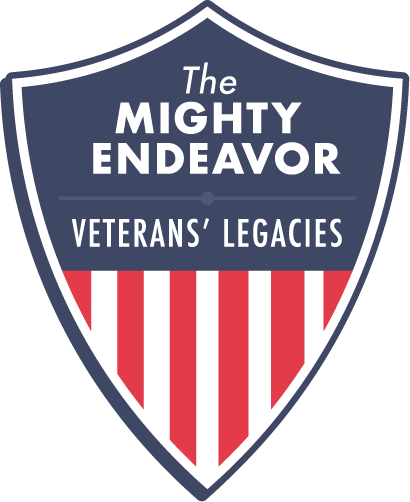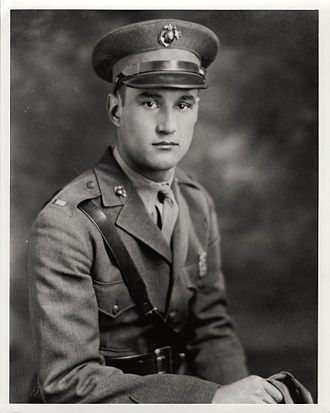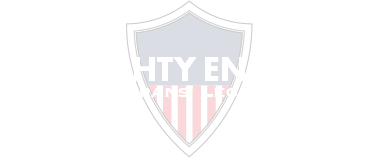Harold William “Joe” Bauer entered the US Naval Academy in Annapolis, Maryland, in 1926, graduating in 1930. Upon his graduation, he was commissioned as a Second Lieutenant in the US Marine Corps. Bauer attended the Officers Basic School in Quantico, Virginia, and then was assigned to company officer of the 1st Battalion, 6th Marines at Quantico. In 1932, Bauer moved from company officer to the assistant coach for the basketball and lacrosse teams, and a marksmanship instructor at the academy until being transferred to the San Diego Naval Base in California as the Assistant Range Officer. Bauer was promoted to First Lieutenant in May 1934 while in San Diego. He was transferred to the Naval Air Station in Pensacola, Florida, in December 1934. It was here that Bauer earned his gold wings as a naval aviator in February 1936. Bauer was promoted to the rank of captain in June 1937, and served with several squadrons in Quantico before being transferred back to San Diego to the Naval Air Station in June 1940. He served as the executive officer of the Marine Fighting Squadron 221, and practiced fighting maneuvers on the USS Lexington and the USS Saratoga. Bauer and the 221 Squadron were placed on the USS Saratoga to Hawaii immediately after reports of the attack on Pearl Harbor came in.
Once they reached Hawaii, Bauer and his crew were sent out again. They were originally assigned to help with the defense of Wake Island, but their orders were changed just as they reached the outskirts of the island. It was decided that the remaining carriers and aircraft available to the US should not be risked unnecessarily. Bauer and his squad were, therefore, redirected to Midway Island and Wake Island was left to its fate. In February 1942, Bauer was given command of the Marine Fighting Squadron 211 when he was transferred back to Hawaii and stationed at the Marine Corps Air Station Ewa on Oahu. He was then given the command of the newly formed 212 Fighting Squadron in March 1942. A month after taking over the 212, Bauer was promoted to Major, and he and his squad were sent to the South Pacific Theater and stationed at New Caledonia, a French territory in the Pacific, and later Efate, Vanuatu (formerly New Hebrides). While at Efate, Bauer was not only responsible for his squad, but also for the airfield and its operation. Bauer was also tasked with finding other sites in the South Pacific on which to create airfields for US use, and training the pilots who were stationed at Efate. In September 1942, a mere four months after being promoted to Major, Bauer was made a Lieutenant Colonel (Lt. Col.). While in the South Pacific, Bauer earned the Medal of Honor, which covered events that took place over several months in 1942 (May to November).
On September 28, 1942, the troops at Guadalcanal, Solomon Islands, received a notification that a squad of Japanese planes were coming in for an attack, out manning the US by two to one. Bauer, having arrived in Guadalcanal that morning on a visit to do the prep work for transferring his squad, volunteered to join the US fighters going up to defend the US's outpost. Bauer returned to land after the Japanese planes had been deterred with his first “kill” – he had successfully shot down an enemy plane. At a later engagement in October, Bauer became an “Ace:” a pilot with five or more confirmed aerial kills. On October 3, Bauer destroyed four planes during the main fighting despite his malfunctioning guns (one or two out of six were working). Afterwards, Bauer noticed a fellow US pilot who had been shot down and was parachuting safely down into the ocean. However, a Japanese plane was strafing (shooting at) the parachute, trying to puncture it. Bauer swept in and defended the downed pilot, causing the Japanese plane to leave the area with a trail of smoke following it. The downed pilot was collected a couple of hours later, in good health, though a bit wet. Though Bauer returned to Efate four days after becoming an Ace, he was soon returned to Guadalcanal, this time with his whole squadron. After covering the 600 plus mile flight between Efate and Guadalcanal on the 16th of October, Bauer was very low on fuel. However, that did not stop him from flying to assist the ship resupplying Guadalcanal: the USS MacFarland. Nine Japanese planes were wreaking havoc on the destroyer, and though the MacFarland had managed to down one plane, she was coming off worse in the fight. In view of the fighter strip on deck, Bauer swept in and shot down four of the Japanese planes within seconds of engaging them, before being forced to land on the ship due to lack of fuel. Lt. Col. Bauer's competence in the air, his leadership, and ability to inspire his fellow soldiers were an integral part in why these missions of the South Pacific were so successful.
On the same day that Bauer assisted in defending the MacFarland, he was made the Commander of the fighter forces on Guadalcanal, meaning that he would now be directing the fighting from the ground and not from the air. Soon after these new arrangements were made, the US fighter planes on Guadalcanal had to defend against the largest force of Japanese planes that had been seen in weeks. With the “dog fighting” or close range aerial fighting taught by Bauer, the US's planes were able to out maneuver and repel the Japanese forces.
In November, the 212th squadron (including its commander, Bauer) were put on temporary leave. They had been in the humid, hot South Pacific for six months with almost constant combat and were thus ready for a break. Bauer, however, chose to stay a few days longer to wrap up some paperwork, when there was another attack by the Japanese. Though other squadrons were responsible for the defense of Guadalcanal at that point, Bauer requested to join the fight in the sky. He was granted permission and in one of the final fights that day, was shot down. While flying low over the water on the way back to base, Bauer and two other planes manned by Captain Foss and Lieutenant Furlow were attacked from behind by two Japanese planes. Bauer destroyed one while Foss and Furlow went after the other. When they returned, they found Bauer alive, swimming through an oil slick made by his own plane. Appearing to be fine and unable to provide any assistance, Foss and Furlow returned to Guadalcanal. They attempted to return to Bauer with the amphibious plane used for rescues, but were delayed until the morning. When Foss returned to the point he saw Bauer last, Bauer was nowhere to be seen. Despite many searches of the islands in the area and the POW camps once the war was over, it was determined that Bauer had died that night, likely of a shark attack or from a Japanese plane shooting him while in the water.
Along with the Medal of Honor, Bauer also received the Letter of Commendation Ribbon, the Purple Heart, the Navy Presidential Unit Citation, the American Defense Service Medal, the Asiatic-Pacific Campaign Medal w/ a bronze star, and the WWII Victory Medal for his service to the US Marine Corps during WWII.
The airfield at Efate had been called Bauer Field unofficially since the end of the war. In 1971, they made the name official with a memorial plaque placed near the field.
Bauer was also honored in 1957 with a US destroyer escort named after him. His wife and son were there to see its first launch.
Sources Consulted:
Army Website, Medal of Honor Recipients, WWII
US Marine Corps, History Division
History Nebraska, Publications
Recommended Reading:








